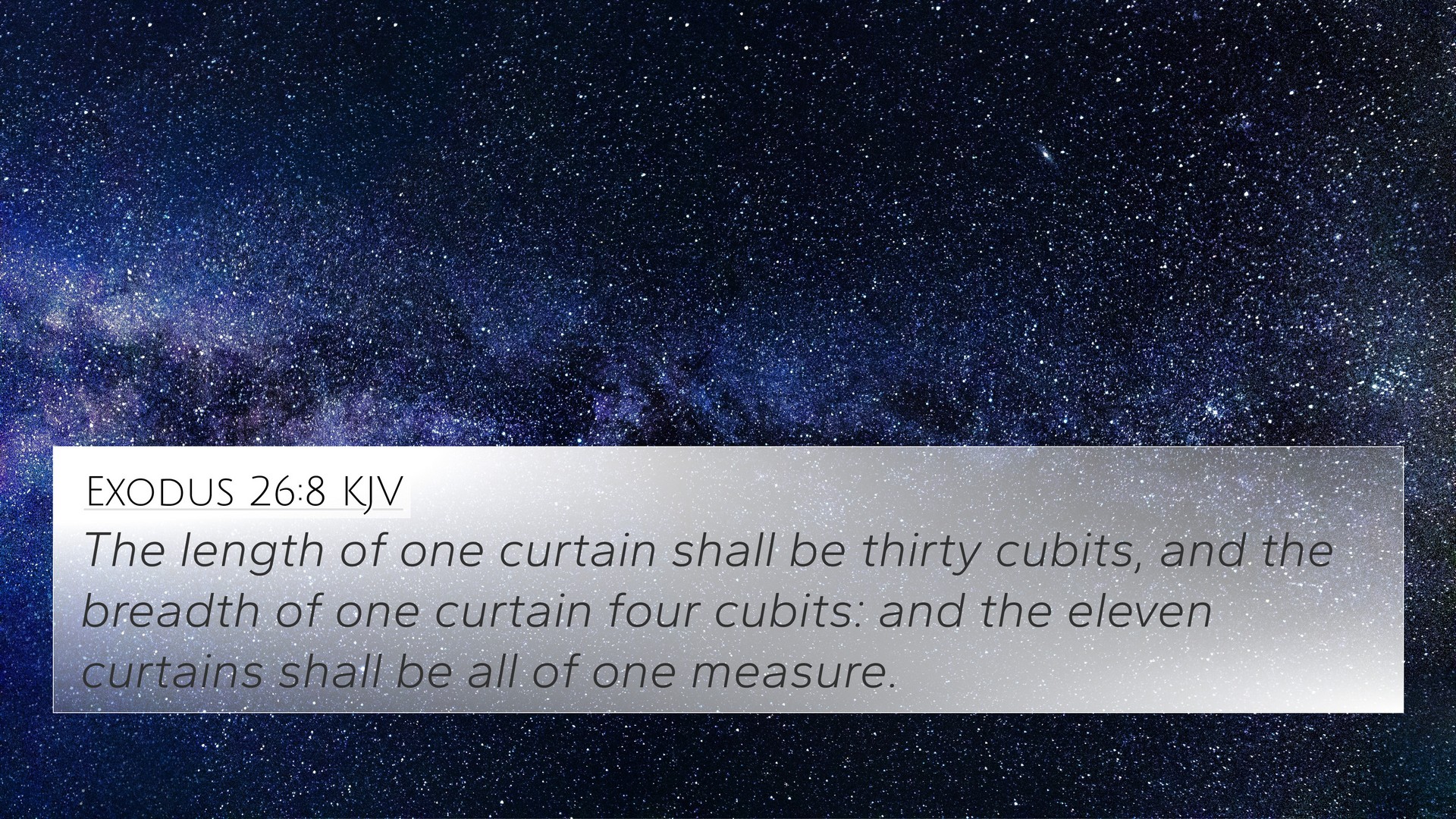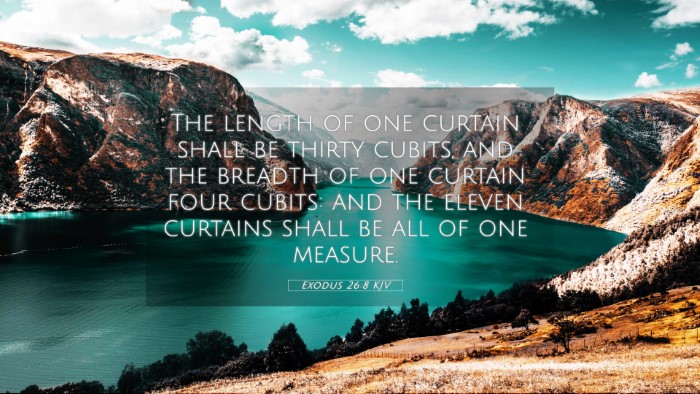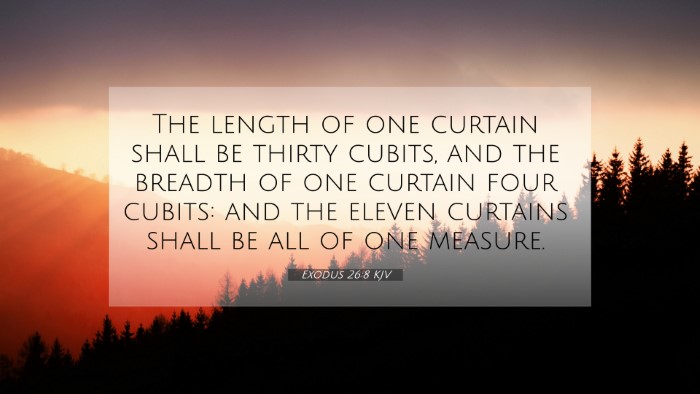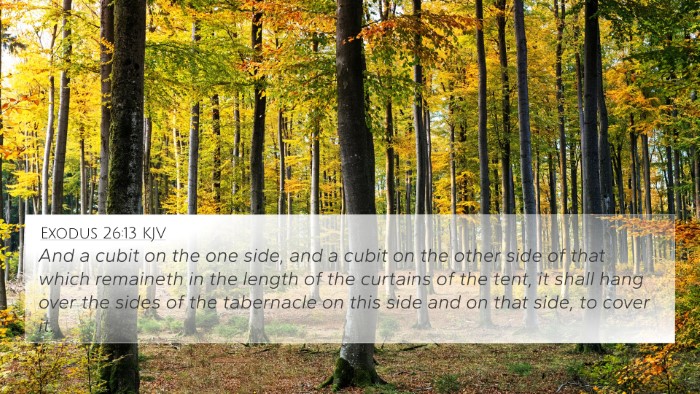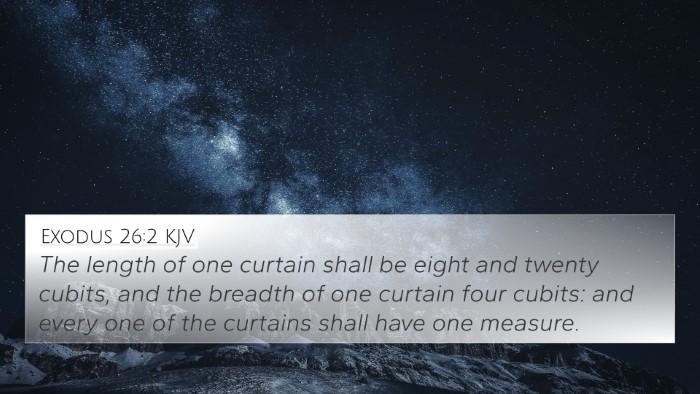Understanding Exodus 26:8
Exodus 26:8 states, "The length of each curtain shall be twenty-eight cubits, and the width of each curtain four cubits. All the curtains shall be the same size." This verse is part of the instruction on how to construct the tabernacle, which served as a dwelling place for God among His people.
Meaning and Interpretation
The verse emphasizes the uniformity and specific measurements required in the materials used for the tabernacle. Below we explore several insights gathered from notable public domain commentaries:
-
Matthew Henry's Commentary:
Henry highlights the significance of the tabernacle's construction as a reflection of divine order. He indicates that the exact measurements symbolize God's perfection and the necessity for His people to follow His divine plan meticulously. The uniformity of the curtains represents the unity of the faith community.
-
Adam Clarke's Commentary:
Clarke emphasizes the historical context, noting how each aspect of the tabernacle's design was intended to inspire reverence and devotion. He draws connections to the heavenly pattern, suggesting that the specifications for the curtains foreshadow heavenly realities.
-
Albert Barnes' Notes:
Barnes provides a detailed analysis of the measurements, discussing the significance of the cubit as a standard of measurement. He also notes that God’s instructions highlight the importance of obedience to His will, as it reflects the holiness required to approach Her divine presence.
Cross References
Exodus 26:8 connects with several other scriptures, which enhances our understanding through cross-references. These connections illustrate the broader thematic elements in the Bible.
- Hebrews 8:5: "The serve at a sanctuary that is a copy and shadow of what is in heaven."
This verse links directly to the heavenly design of the tabernacle.
- Exodus 36:8: "And every wise-hearted man among them that wrought the work of the tabernacle made ten curtains of fine twined linen."
It emphasizes the unity and craftsmanship involved in the creation of the tabernacle, paralleling the dimensions given in Exodus 26.
- 1 Chronicles 28:11: "Then David gave to Solomon his son the pattern of the porch, and of the houses thereof, and of the treasuries thereof, and of the upper chambers thereof, and of the inner parlors thereof, and of the place of the mercy seat."
This verse shows the continuity in God’s instruction through different times of building His dwelling among people.
- Romans 12:1: "I beseech you therefore, brethren, by the mercies of God, that you present your bodies as a living sacrifice, holy, acceptable to God."
Symbolizing the sacredness and holiness required to approach God, similar to approaching the tabernacle.
- Revelation 21:3: "And I heard a loud voice from the throne saying, 'Look! God’s dwelling place is now among the people, and He will dwell with them.'"
Highlights the ultimate fulfillment of God dwelling among His people.
- John 1:14: "The Word became flesh and made His dwelling among us."
Offers a New Testament connection illustrating God’s presence among humanity.
- 2 Chronicles 3:1: "Then Solomon began to build the house of the LORD at Jerusalem in mount Moriah."
Connects the continued theme of God’s dwelling in the context of scriptures concerning sacred spaces.
Thematic Connections
The verse and its connections provide profound insights into several themes:
- Divine Order and Instruction: God gives precise specifications for the tabernacle, which symbolizes the importance of adhering to His guidelines.
- The Holiness of God: The emphasis on uniformity and specific design reflects God's holiness, influencing how the people approach Him.
- Unity in Worship: The uniform curtains illustrate the communal aspect of worship, signifying all believers are called to unity under God's guidance.
- Foreshadowing in Scripture: The construction instructions serve as a foreshadowing of Christ’s ultimate sacrificial offering and God’s unfolding plan for redemption.
Using Bible Cross-References
The links provided not only deepen one’s understanding of Exodus 26:8 but also serve as an effective study tool for those who desire to delve deeper into scriptural connections. Here are a few methods and tools for effective cross-referencing:
- Utilize a Bible concordance to find verses that may share similar themes or keywords.
- Adopt a Bible cross-reference guide during study sessions to reveal interconnections.
- Engage in cross-reference Bible study methods to enhance your understanding and retention of biblical principles.
- Explore comprehensive Bible cross-reference materials that provide links to various verses across scripture.
Conclusion
The verse Exodus 26:8 has significant theological implications and serves as a reminder of God's order and holiness. Through interconnected scriptures, believers gain insights into God's presence and the profound relationship between humanity and the divine. Engaging in cross-referencing and understanding connections between Bible verses enriches both personal study and collective worship experiences.
